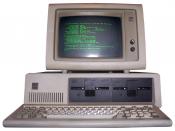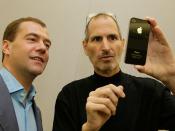Xerox, Apple, IBM, and Compaq all played major roles in the development of the Personal Computer, or "PC," and the success of Microsoft. Though it may seem so, the computer industry did not just pop-up overnight. It took many years of dedication, hard-work, and most importantly, thievery to turn the personal computer from a machine the size of a Buick, used only by zit-faced "nerds," to the very machine I am typing this report on.
Xerox started everything off by creating the first personal computer, the ALTO, in 1973. However, Xerox did not release the computer because they did not think that was the direction the industry was going. This was the first of many mistakes Xerox would make in the next two decades. So, in 1975, Ed Roberts built the Altair 80800, which is largely regarded as the first PC. However, the Altair really served no real purpose.
This left computer-lovers still yearning for the "perfect" PC...actually, it didn't have to be perfect, most "nerds" just wanted their computer to do SOMETHING.
The burning need for a PC was met in 1977, when Apple, a company formed by Steve Jobs and Steve Wozniak, released it's Apple II. Now the nerds were satisfied, but that wasn't enough. In order to catapult the PC in to a big-time product, Apple needed to make it marketable to the average Joe. This was made possible by Visical, the home spread sheet. The Apple II was now a true-blue product.
In order to compete with Apple's success, IBM needed something to set its product apart from the others. So they developed a process called "open architecture." Open architecture meant buying all the components separately, piecing them together, and then slapping the IBM name on it. It was quite effective. Now all IBM needed...


